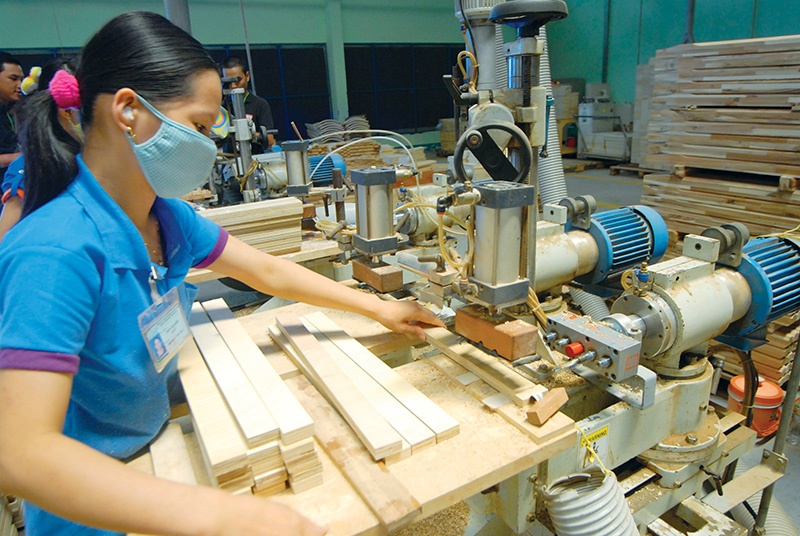Timber tainted by slump in overall productivity
 |
| Many furniture manufacturers in the country are short of workers. Photo: Le Toan |
Production in Vietnam’s timber sector has almost returned to pre-April values, and Thuong Nguyen Woodworking Machinery Co., Ltd. remains busy. The company is implementing a new production process including a new system, the installation of new equipment, and an improvement of the technical training and skills for workers.
Director Duong Tu Trinh said that automation is now applied to eliminate inefficient steps and contribute to profits. “New technology helps us eliminate the manual colour cleaning process and triple productivity,” Trinh said. Thuong Nguyen produces woodworking machines for domestic enterprises, as well as for export.
The firm has managed to save about $2,600 in electricity bills each month by “changing the production time frame,” Trinh said. However, Trinh also acknowledged that such adjustments are only effective at small companies, with about 200-300 workers.
Pandemic-related factory closures and capacity constraints have eased in recent weeks. In October, the General Department of Vietnam Customs recorded exports of timber and products thereof at $945 million, up 35.6 per cent over the previous month. However, this recovery was not balanced and the decline in output per worker or unit of capital continues to remain at Asia’s second-largest furniture supplier.
Vietnam’s wood processing industry has developed strongly over the past 15 years after it became a member of the World Trade Organization, with production capacity quadrupling compared to 2003. The country’s industry has mainly been thriving thanks to abundant labour resources and low labour costs.
Factories and workers are now more efficient as they gradually adopted market-oriented policies and technological advancements. However, Vietnam’s productivity growth, including in the timber industry, has slowed markedly in recent years. According to estimates from the International Labour Organization (ILO), Vietnam’s labour productivity increased by only 5.4 per cent last year, while it was 6.2 per cent in 2019. Last year’s level was the lowest in the past five years.
Meanwhile, the pandemic continues to deepen the productivity gap that existed before the crisis. Do Xuan Lap, chairman of the Vietnam Timber and Forest Product Association, said that furniture manufacturers have made most of the investments they can to restore production, but are short of workers.
The association’s surveys show that social distancing had reduced the production capacity of the largest wood processing companies by 30 per cent compared to before April. The industry is short of labour, while capacity had generally increased. But due to missing workers, production times have now increased to as much as 120 days, while in 2018 it was 75 days.
“Long-term growth must come from productivity,” Lap said. “The annual productivity growth rate of the industry has not improved, as most enterprises are small- and medium-sized ones, which are short of capital and hesitant to invest in upgrades.”
In the southern province of Binh Duong, businesses need to recruit more than 50,000 unskilled workers for production at the end of the year, according to statistics from its Department of Labour, Invalids. and Social Affairs. Some large companies like Hoang Thong and Timberland are looking for around 1,000 more workers to speed up production soon. They are willing to increase basic salary and coordinate with the provinces to welcome workers back to Binh Duong.
The government has managed to push productivity at an average increase of 5.8 per cent in the last five years, which was higher than in the 2011-2015 period with about 4.3 per cent on average. Yet, labour productivity in Vietnam is still 26 times lower than that of Singapore, seven times lower than that of Malaysia, and only a quarter of China’s, according to the ILO, posing a challenge to the Vietnamese economy.
When businesses rethink their production models, workers often produce more efficiently, supported by applying market orientations and technological advancements. But Assoc. Prof. Dr. Vu Thanh Hung, director of the Institute of Business Administration at the National Economics University, said that it is not an urgent issue that needs to be solved in the next few years, as improving labour productivity requires joint efforts, links, and integration.
“What needs more attention is the improvement of organisational and management capacity. Improving productivity is simply getting one thing done in less time, or at the same time, making more products with higher added value. All of this is within the reach of each business,” Hung argued.
What the stars mean:
★ Poor ★ ★ Promising ★★★ Good ★★★★ Very good ★★★★★ Exceptional
Related Contents
Latest News
More News
- Businesses ramp up production as year-end orders surge (December 30, 2025 | 10:05)
- Vietjet chairwoman awarded Labour Hero title (December 29, 2025 | 13:06)
- How to unlock ESG value through green innovation (December 29, 2025 | 10:03)
- AI reshapes media and advertising industry (December 29, 2025 | 08:33)
- FPT and GELEX sign deal to develop blockchain tech for global markets (December 29, 2025 | 08:29)
- Vietnam’s GDP forecast to grow by 9 per cent in 2026 (December 29, 2025 | 08:29)
- Women entrepreneurs are key to Vietnam’s economic growth (December 29, 2025 | 08:00)
- Vietnam's top 500 value-creating enterprises announced (December 27, 2025 | 08:00)
- The PAN Group shaping a better future with ESG strategy (December 26, 2025 | 09:00)
- Masan Consumer officially lists on HSX, marking the next phase of value creation (December 25, 2025 | 13:20)

 Tag:
Tag:



















 Mobile Version
Mobile Version